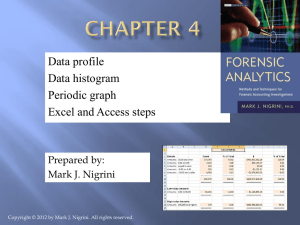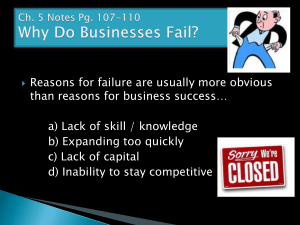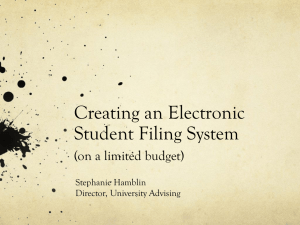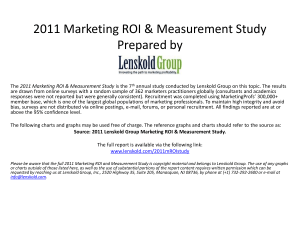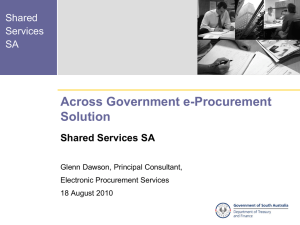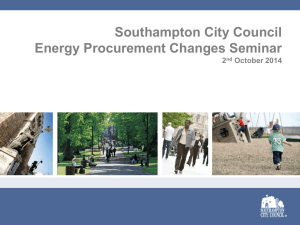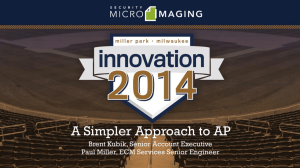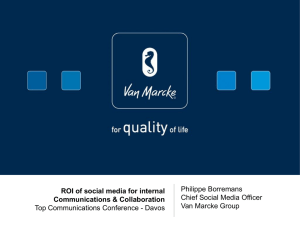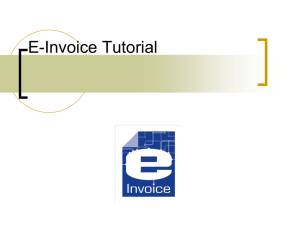The 7 Steps to Go Paperless - Florida Government Finance Officers
advertisement
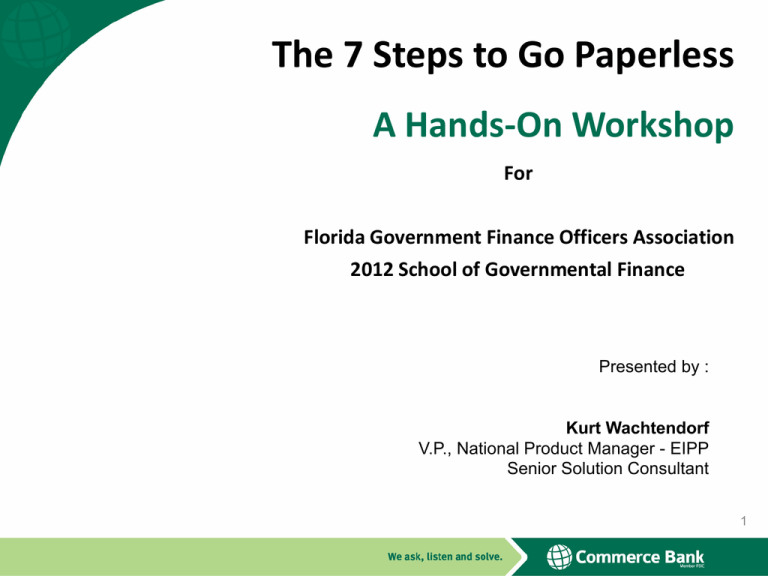
The 7 Steps to Go Paperless A Hands-On Workshop For Florida Government Finance Officers Association 2012 School of Governmental Finance Presented by : Kurt Wachtendorf V.P., National Product Manager - EIPP Senior Solution Consultant 1 Your Workbook • You received a workbook when you registered • This workbook will be used throughout the workshop – All content is in the workbook – Your exercises are in the workbook – Use it to take notes, write down ideas and follow-up items • The workbook will become the first draft of your Solution Design 2 Making Sense of the Alphabet Soup EDM (Electronic Document Management): the management of different kinds of documents in an enterprise using computer programs and storage. ECM (Enterprise Content Management): the technologies, tools, and methods used to capture, manage, store, preserve and deliver information, content, and documents related to organizational processes DM (Document Management): The capture and management of documents within an organization Workflow: The automatic routing of documents to the users responsible for working on them BPM (Business Process Management ): a systematic approach to improving an organization's business processes DI (Document Imaging): The online storage, retrieval and management of electronic images of documents. EIPP (Electronic Invoice Presentment and Payment): The Commerce Bank Solution 3 Business Challenges • Paper-intensive, inefficient business processes – – – – Need automated workflow functionality for AP and other processes Gain new levels of efficiency without adding staff Eliminate paper processing and reallocate staff to value-added work Solve issue of processing and distributing paperwork across departments and locations – Missed discounts – Streamline audit preparation and response time – Manual data entry is prone to error 4 What drives organizations to go paperless? • • • • Intensive, paper-based, manual processes – Time consuming activities (shuffling paper, copying, filing, etc.) – Difficult to track (lost documents, filed in wrong folder, setting on someone’s desk) – Matching invoices to PO’s and/or Receivers Managing high volume of documents from different sources – Receive faxes, emails, EDI and LOTS of paper from many locations High document processing and storage costs – File cabinets occupying expensive real estate – Paying for outside storage Lack of visibility of invoice and other documents in the process – What happened to that documents I sent you? 5 Small or large, size doesn’t matter • “We have years of paper documents stored everywhere. Our hallways are overflowing with file cabinets filled with paper. We can’t afford not to be in control of how our paperwork is processed. Our environment demands it.” • “Even as a private organization, our paperwork trail for doing business day-in and day-out is incredible. Getting control of how we process documents means time and money saved. And in today’s aggressive business environment, that gives us a competitive advantage.” 6 Why are you here? 7 What Would You Like To Accomplish • List 5 things you’d like to accomplish today 1. 2. 3. 4. 5. 8 What would you like to accomplish? • 5 things you’d like to accomplish today What can a paperless process do for me? Learn what other organizations are doing with their processes How to get my project on track Calculate ROI and present a business case for my project Network 9 Have you ever asked yourself… • • • • • • • • Why exactly are we doing this? How do we implement this solution? Do we know the expectations of the solution? Why have we started with this process? How long will it take? Who will manage the project? Has anyone seen a project plan? How much will this cost me? 10 It’s like there is a wall between us 11 The answer: Solution Design Solution Design is a tool that helps you understand the problem, design a solution, and plan the approach in a way that gives you complete control over the project and its outcome. 12 Taming your projects The Solution Design helps you: – Solidify your understanding of the problem and the desired solution – Select the best solution provider – Ensure everyone is on the same page – Document clear objectives – Create a feasible schedule – Get commitment to implementing the solution you need – Define a common language among the team and when talking with solution provider – Describe the requirements and the expected results – Avoid surprises! 13 The 7 Steps to Go Paperless 14 Step #1 Understand the Problem 15 Step 1: Understand the Problem • Involve key users/departments and understand the problem: – – – – – – – – – – – – Paper reduction in the workplace Too many file cabinets Difficulty in finding information (time + costs) Distributed offices make it challenging to share documents Need for increased security in accessing information Industry/Government regulations Too many systems, not integrated, difficult to distribute documents Time and cost to retrieve and distribute documents Managing the approval process Fax machines, MFD (Multi-Function Devices), scanners, etc. Sorting and delivery Slow response to inquiries 16 Mails / Faxes PO to vendor User fills out requisition form Walks to Purchasing to deliver requisition Sends copy to Accounting Enters PO in the system Prints approved PO File copy in Purchasing Sends copy to Receiving Locate receiving document Match to packing slip Notate exceptions Sends copy to Approver AP receives documents Accounting files copy Sends copy to Accounting Advanced Shipping Notification A/P Receiving Purchasing P2P Process – Executive View Makes copies Matching of documents Accept order Make copies of documents NonConforming Reconcile process Files in receiving Sends copy to Purchasing GL Coding Purchasing files copy Voucher entry Print checks Conforming Match checks with paperwork Approve / Sign Mail 17 P2P Process – User View 18 Purchasing Process – Real World 19 Receiving Process – Real World 20 AP Process – Real World 21 Step 1 Exercise • List the top 10 problems / bottlenecks of your Purchase-to-Pay process from your perspective. 22 Step 1 Exercise • List the top 10 problems / bottlenecks of your Purchase-to-Pay process from your perspective. 23 What others say… • Customer AP Problems - Examples: Average time taken from receipt of invoice to payment: 42 days On average, 3.6% of invoices handled by AP have errors Cost to reproduce documents for audits or customer research Lack of control during approval process Cost of manually handling, checking and processing a paper invoice and cutting a paper check: $8 to $12 dollars Taking advantage of vendor discount offers due to processing time 2 Way & 3 Way matching of PO’s, Receivers, and Invoices are manual Multiple AP processing locations creating redundancy and delivery cost Increased cost of postage for mailing purchase orders and checks Average days in payables is too high / too low Average cost to process vendor payment: $8.15 24 Step 1 Exercise Review • Tips to help you out: – – – – – – – – Think about the process you go through every day in your functional areas Where does the process break down? How much time is your payment process taking? What keeps you from taking advantage of discounts when paying invoices? How can you improve the process? Does it take too many people to get things done? What is it about your process that keeps you up at night? What other departments interact directly and indirectly with you? Who sends you requests, approvals, etc.? Who asks you for reports? – How many (and who are they) external entities do you interact with? Vendors, customers, partners… how do they affect your process? – Sit down with your users and managers and document your process – ASK YOUR USERS 25 Action Step – write this down • Ask the users to list their Top 10 Problems/Bottlenecks • List their names • Verify whether their list matches mine 26 Step #2 Identify Goals and Requirements 27 Step 2: Identify Goals and Requirements • What would you like to accomplish? – – – – – – – – – – – Eliminate paper-based retrieval Provide immediate access to AP related documents Automate routing of exceptions to the proper person Streamline workflow and exception handling process Provide automated audit trail to meet regulations Reduce people costs / time Eliminate off-site storage Notification of exception invoices Make more space available Take full advantage of AP discount opportunities in a more timely manner Consolidate operations in one single office, eliminating redundant processes at other locations 28 Step 2: Identify Goals and Requirements • What would you like to accomplish? (Continued) – Utilize immediate access to information for more timely and accurate analysis – Provide access to all authorized users at any location from their workstation – Electronically capture invoices when they arrive and utilize electronic workflow for approval and processing – Reduce or eliminate the need for multiple copies of certain documents – Reduce labor expense for processing these documents (printing, copying, filing document research, etc.) – Reduce mailing and shipping costs associated with delivery of documents to and from remote locations – Reduce time and work effort for audits with imaged documents – Reduce cost of check payments 29 Step 2: Identify Goals and Requirements • Key questions – What are the manual steps in the process (photocopying, delivery, sorting, following-up on approval)? – Can we automate anything in the purchasing process? – Can we centralize any of the Purchase-to-Pay processes? – How do you handle receiving documents (invoices, other docs, etc.)? – How do you send your payments? – Who and how do you get your checks signed? – Who needs to review and approve invoices with exceptions? – How do you file and retrieve the documents? 30 Step 2 Exercise • List the goals you would like to accomplish with a paperless solution. • You can break it down by functional area (purchasing, receiving, and accounts payable) to make it easier. 31 Step 2 Exercise • List the goals you would like to accomplish with a paperless solution. Functional Area: ________ Functional Area: __________ Functional Area: __________ 32 Action Step – write this down • Do my goals match the organization’s goals? • I will NOT let my current situation cloud my vision for the future! 33 Step #3 Map the Current Process 34 Step 3: Map the Current Process • It’s more than just technology – Think about the documents you receive or create Invoices, Packing Lists, Bills of Lading, Purchase Orders, Credit/Debit Memos, AP Checks, Receiver Reports generated from your business application – Think about the ways in which you send/receive documents Faxes, Emails, Mail – It is more than simply transforming paper into image format, it includes: Scanning, Indexing, Archiving Searching, Retrieving Sending it out to other people for approval, getting alerts and notifications, etc. Integrating into your business application – AND it includes integrating your business process into the equation 35 Step 3: Map the Current Process • How to map the current process: – – – – – – – Identify points of origin, decisions and where it ends Map the process, not only one task Identify all personnel involved Identify potential user issues Identify all integration points with core applications Identify document-related as well as activity-related tasks Identify the ‘problem areas’ or ‘opportunity areas’ 36 Step 3 Exercise • Map your current process: – Create the flow for your current Accounts Payable process, using the previous example as a template – Tips to help you out Think about the functional areas first, and list all activities that happen there (e.g. Purchasing) Think about the activities that cross functional areas List exceptions - There are always exceptions Are all invoices handled all the same way? How does email play in the process? Do you have a clean audit trail? How many people are involved in handling each document? Is the process the same in other locations? 37 Action Step – write this down • I will remember to always keep the following in mind: – – – – – What Who When Why … and what if… ? 38 BREAK? 39 Step #4 Design the Solution 40 Step 4: Design the Solution • • • • • • Explore different scenarios to solve the problems identified Validate chosen scenario with key users Identify the technology required Identify changes to business processes, business rules, etc. Prioritize implementation plan Schedule review of solution design with executive management 41 Example Accounts Payable Before: 42 Example Accounts Payable After: 43 Step #5 Calculate ROI 44 Step 5: Calculate ROI • Hard Savings – – – – Reduction / Reallocation in personnel Business operating costs (paper, photocopying, postal mailing, courier services) Reduction in infrastructure costs (sell a building, remove filing cabinets, etc.) Increase in productivity measured by man hours saved not handling paper (standing at fax machine, looking for lost or misplaced files, etc.) – Increased cash flow (vendor discounts, improved terms, payment options, etc.) – Reduction in cost of processing invoice – Go Green • Soft Savings – Improved vendor/user service – Better and faster access to information – Faster internal communications 45 Step 5: Calculate ROI • One of the best ways to fully capture ROI is to understand what the current costs are (Step 3) and identify how much you will save by implementing a paperless solution (Step 4) 46 Step 5: Calculate ROI • Areas to look at for savings: – – – – – – – – – – – – Legal mandates and regulatory compliance – Sarbanes-Oxley, SEC Rule 17 Off-site storage costs and retrievals for existing documents Labor reductions possible or additional labor required in the future Employee retention Remote access to documents – no need to FedEx, fax, and/or courier documents Electronic voucher entry Filing, retrieving, document, matching, audit preparation Lost documents (a lost document may cost as much as $150 to replace) Misplaced documents – search Allows increased productivity around shared documents Reduced printing, mailing, faxing, special delivery costs Reduced storage costs from eliminating paper 47 Step 5: Calculate ROI • Areas to look at for savings (continued): – – – – – – – Electronic payment options Overall document management costs for existing resources and facilities Cost of file cabinets/cost of file cabinet real estate Cost of off-site storage and retrieval Cost of paper, paper clips, staples, folders, index cards, etc. Cost of printing and printers (total cost of ownership for printers) Moving documents between departments/locations and making better decisions quicker – Improved security – Disaster recovery 48 Step 5: Calculate ROI • Examples of areas to analyze – Accounts Payable – – – – – – – – – – – – Invoices sorted into groups (PO vs. Non-PO) Delivery of sorted invoices to users Coping/scanning and emailing problem invoices Delivery of problem invoices to approvers Delivery of resolved invoices back to AP Invoices sorted and packaged for delivery to corporate from remote locations Copying and filing each location Wasted time trying to track problem invoices External auditor - AP user’s time Filing of completed invoice packets Invoices matched to related documents Filing of invoices, statements, order acknowledgements 49 Step 5: Calculate ROI • • The cost of handling paper: – Knowledge workers spending >20% of their time on document management tasks – The average document is copied, either physically or electronically, nine to 11 times at a cost of about $18 – Documents cost about $20 each to file – Retrieving a misfiled document costs about $120 – Average cost of faxing a document: $2.60 – Average cost of printing and distributing a paper form: $0.17 per page – Average cost of the process of creating, modifying, printing and distributing a paper form: $1.26 per page Going “Green” can save money and the environment: – One tree yields 8,333 sheets of paper – Each office workers print 1,000 pages per month (10,000 to 12,000 year) – 45% of documents are thrown out within 24 hours – 768 million trees to produce world’s annual paper supply – Energy consumption (12% of total manufacturing energy) 50 ROI 51 ROI 52 ROI – Results 53 Step #6 Document and Present 54 Step 6: Document and Present • Helps solidify your ideas, the goals, the analysis and all other steps you took until now • Gives other people an opportunity to review the Solution Design as a whole (some people may have only participated in parts of this process) • Good way to ensure everyone is literally on the same page • You can always go back to the document to check why certain things are (or are not) being done • You have something to hold the Solution Provider accountable 55 Contents of a Solution Design • • • • • • • • Executive Summary Goals and Requirements Current Process Solution Overview Proposed Solution Benefits Return on Investment Implementation Methodology 56 Now what? • You’ve presented the Solution Design and your team has bought in, it’s time to kick-off the Technical Design. 57 How technology projects are usually carried out! 58 What the user requested 59 What IT specified 60 What the vendor suggested 61 What the proposal described 62 What the team implemented 63 The tech support you received 64 What you were charged for 65 What was really needed 66 The results are well-known • • • • • • • Lack of communication between IT and users Lack of understanding from the vendor of what the problem really is Resistance from users on changing the way they usually do things System integration issues Short-term focus sacrificing long-term viability Scope creep Missed deadlines 67 About that project management thing… • 49% of IT projects fail 1 • Total U.S. project waste is $55 billion ($38 billion in lost dollar value and $17 billion in cost overruns) 1 • 55 % to 75 % of IT projects fail to meet their objectives 2 • 40% are never fully implemented • Executives from 117 organizations stated that support costs after software implementation were 20% over original estimate 3 • 86% of projects fail for reasons other than technology 4 • 32% of project failures occur due to poor project management skills 4 1: 2010 CHAOS Report, Standish Group; 2: META Group; 3: The Conference Board Survey; 4: KPMG Information Risk Services study 68 So Solution Design is the… or Business Design 69 Step #7 Implementation (Activation) 70 Implementing a Solution Initiate & Plan •Strategic Vision •Current Process Review •Statement of Goals & Objectives •Executive Sponsor Meeting •Solution Design Control & Execute •Onsite Workshop •Revise Solution Design •Project Plan •Payment Solution Installation •Integration & System Conversion •Status Updates Stabilize & Close •User Training •Project Launch •Project Summation •Ongoing Support • Post Launch Recommendations & Next Steps 71 Implementation Plan should include: • Project Management • Defined Process – Phase 1 – PLANNING – Phase 2 – EXECUTION – Phase 3 – STABILIZE • Responsibilities / Requirements – Client Responsibilities – Provider Responsibilities 72 Did we accomplish everything? • Let’s go back to the list we created in the beginning of this workshop. 73 Wrap-Up 74 The Seven Steps to Go Paperless 75 Things to keep in mind Involve key users along with management Understand how things are done today (the flow, the documents, the systems, etc.) Identify the costs associated with current processes (this will be later used for ROI) 76 Things to keep in mind Look at the full process, not just an activity (functional areas) Accept change (change really can be good) Use the Solution Design to guide your selection for the correct solution provider 77 Things to keep in mind Document your findings, your goals, requirements, etc. Plan, then review, then stick to the plan Take pride in what you accomplished! 78 Summary • Paperless projects are more than just technology • Use the Solution Design to understand the problems, how to solve them and set goals • Select a solution provider that can help you with a Solution Design… • … or use the Solution Design to help you select a solution provider • Beware of those who say “you don’t really need this, just trust me” • Project management is key to any implementation. Be on top of it and make sure there is a methodology and a process in place 79 About Commerce Bank Strength, Stability and Growth for over 140 years Established in 1865; Family operated Top 50 bank holding company based on asset size, assets of $18 billion 11.5% annual EPS growth over past 10 years One of the largest banks in the country that declined TARP funds Issuing commercial cards for more than 40 years Top 10 on Forbes magazine’s list of Best Banks three years in a row Consistently ranked in the Top 10 Best Performing Banks by Bank Director magazine 80 Next steps • • • • Review your workbook Get together with other users/departments Use the workbook and start planning your Solution Design in detail If you’d like us to help you with your Solution Design, contact us 81 How do you feel? 82 Learn more Kurt Wachtendorf Vice President National Product Manager – EIPP Senior Solution Consultant kurt.wachtendorf@commercebank.com 918-622-8489 - office 918-691-7911 - mobile www.commercebank.com www.commercebank.com/eipp 83
